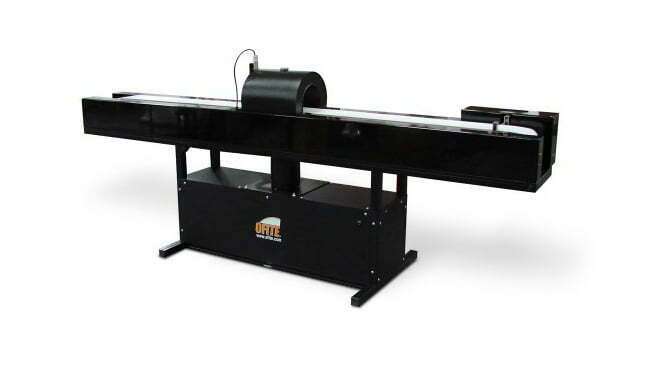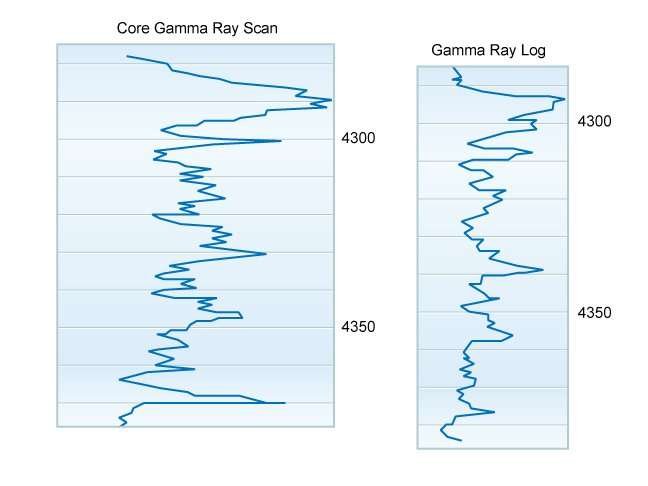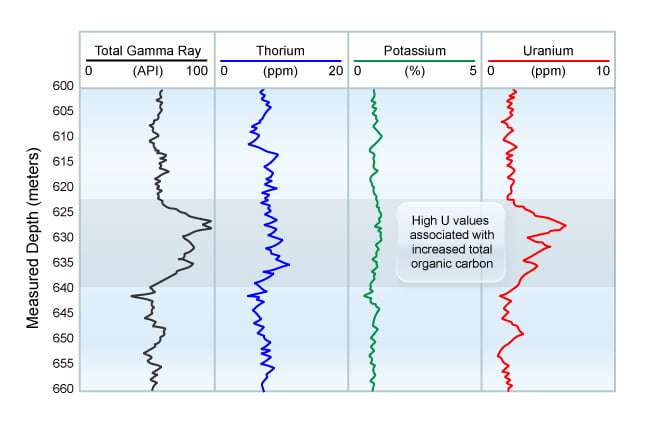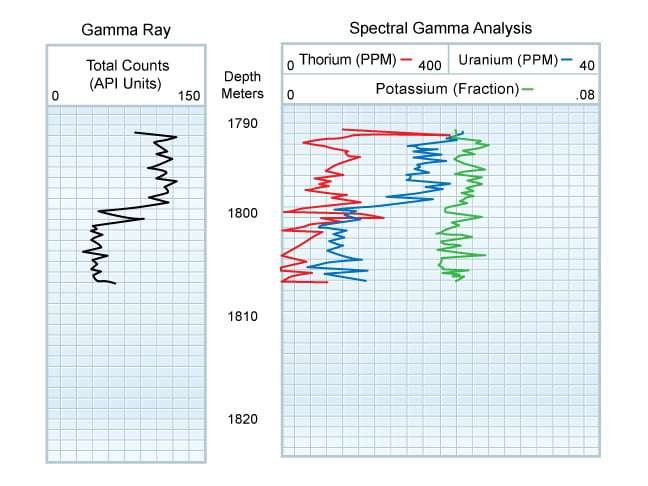Core Gamma Ray Log
The natural gamma ray radiation of the core may be sensed in the laboratory with instrumentation (Figure 1) similar to that used in the LWD and wireline well log tools. This radiation is generally attributed to the presence of uranium minerals, thorium or the potassium isotope K-40. Shales typically have high gamma ray activity, carbonate rock activity is normally low in general (except with intense dolomitization and mineralization), and sandstone radiation frequently falls between these two levels. Anhydrite and halite evaporites often have very low gamma ray readings. The gamma ray radiation tool is used for discerning the broad lithological changes, bed boundaries and for correlation. The data it generates are referred to as the core gamma ray log.

In the laboratory, the core sample is placed on a motor-driven conveyer belt and travels through a lead-shielded tunnel containing a scintillation gamma ray detector. Impulses from the detector are electronically integrated, and the output is recorded on a log at the same scale as that used for the downhole gamma ray logs to facilitate correlation between them.
Gamma ray measurements in the laboratory are generally performed on continuous, full diameter cores, not sidewall core samples. Data are recorded in chart form for comparison with the visual assessment of the core lithology, and for depth correlation with the downhole logs.
By aligning the peaks and troughs of the laboratory-measured gamma ray radiation profile with those of the LWD and/or wireline gamma ray logs (Figure 2), the depth recorded on the core can be shifted to the depth on the downhole logs.

Because natural radioactivity has a statistical element and the two gamma ray logs are acquired at different logging speeds, good interpretation judgment is needed to make the optimal correlation. The convention is to adjust the core analysis depth profile to correct it to the downhole log depths. Core depths are computed by counting the pipe joints recovered from the borehole on tripping out the bottomhole assembly. In some cases, a joint (30 ft, or 9 m) or stand (90 ft, or 27 m) may be missed in the pipe tally. It is common to find depth discrepancies of 3 to 7 ft (1 to 2 m) between the log depths and the core depths. When no correlation is initially found between the two, it is advisable to shift the depth in intervals of 30 ft (9 m), being the length of one joint of drill pipe, to see if a good correlation can be found. If cores are jumbled during their assembly and transport, or boxed in inverted order, the core gamma ray can help to rectify the situation.
The output of the natural gamma ray radiation tool is in a digital format and stored for later use. The data can be re-plotted at various depth scales for various correlations and interpretations, or presented in a tabular printed report. Usually the surface measurements of gamma ray radiation can be completed within an hour, and are ready for immediate comparison with the physical characteristics of the core and for correlation with downhole LWD and wireline logs from the same, or nearby, wells. These data are usually reproduced on a log of the core, along with other basic laboratory information.
Cores that were not originally measured for gamma ray radiation and that have been stored for periods of time can still be suitable for this measurement. Samples that were previously analyzed, cleaned and dried are also suitable candidates. Samples that have been preserved with CoreSealTM can be tested without removal of the preservative material. It is recommended that cores not be tested within closed wooden or cardboard boxes because this inhibits proper fitting of the core prior to sensing its gamma ray activity. When rubber sleeves are within the unopened boxes, for example, zones where the sleeve has collapsed because of sand washout will not be identified.
Spectral gamma ray analysis presents not only the total gamma activity, but also separates the individual components contributed by uranium, potassium and thorium (Figure 3).

In some depositional environments, the presence of significant quantities of mica and clays within the pore structure or rock fabric has caused hydrocarbon productive zones to be highly radioactive and, thus, superficially to appear to be shales. The use of the spectral gamma ray log assists in identifying such zones of higher radioactivity, indicated by the relevant log curve deflecting to the right. Figure 4 illustrates a core gamma ray surface log (traditional laboratory gamma ray radiation test) and the associated core spectral gamma ray log.

 Petro Shine The Place for Oil and Gas Professionals.
Petro Shine The Place for Oil and Gas Professionals.



